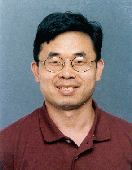CVPR Tutorial on Nonlinear Manifolds in Computer Vision
Sunday, June 27th, Washington DC
This tutorial on nonlinear manifolds in computer vision is divided into
four segments consisting of:
- A discussion of problems in computer vision that motivate
the study of geometric properties of manifolds;
- An informal introduction to the basic elements of the theory of
differentiable manifolds, illustrated with examples that are
relevant to the study of vision problems;
- A discussion of optimization and statistical inference techniques
on non-linear manifolds;
- A demonstration of several vision algorithms developed with methods
of stochastic differential geometry.
The final version of the presentation is available
here in pdf format.
A list of useful references is available
here.
Motivations
Studies on nonlinear manifolds in computer vision are primarily driven
by vision problems. Here we list a few examples to illustrate the relevance
and importance of nonlinear manifolds.
-
Pose estimation. Given an image of a known object, the problem is
to estimate its pose (or orientation) with respect to a fixed
frame of reference. Representing the pose by elements
of the group SO(3) of 3D rotations, this becomes a
problem of statistical estimation in SO(3).
The problem can be generalized to the estimation of position and
orientation of objects.
- Optimal Component Analysis. Linear projections of images
to low-dimensional subspaces are proving to be important in many applications.
PCA, ICA, FDA and sparse representations are all examples of this idea.
How to find a projection that is suited to a particular application?
This can be seen as an optimization problem on a Grassmann or
Stiefel manifold.
- Statistical Shape Analysis. Several representations of shapes
of objects lead to the study of the geometry of shape manifolds.
The analysis of shapes calls for the development of tools for statistical
inferences on shape manifolds. We will discuss Kendall's shape spaces
and other manifolds used in modeling planar shapes.
- Structure from Motion. In the investigation of structure from
motion, problems involving the estimation of matrices satisfying some
nonlinear constraints arise, which can be phrased as inference problems
on a nonlinear manifold.
- Image Manifolds. With the prior knowledge that a collection
of images can be represented as elements of a low-dimensional manifold
in a larger Euclidean space, one wishes to estimate or discover this
image manifold. Isomaps, LLE, and Laplacian eigenmaps are some of the
approaches that have been proposed.
Technical Description
-
Differentiable Manifolds
We present the fundamental concepts of differential calculus on manifolds
and some basic notions of differential geometry in an informal,
intuitive manner. We also explore many examples that are relevant to
applications in computer vision.
-
Definition and examples of differentiable manifolds:
Euclidean space Rn, submanifolds of Rn, projective spaces,
classical Lie groups, Grassmann manifold, Kendall's and other shape manifolds.
- Tangent vectors and tangent spaces.
Elements of differential calculus on manifolds.
- Riemannian metrics. The normal bundle of a submanifold.
Gradient vector fields. Geodesics and the exponential map.
- The flow associated with a vector field. Numerical calculation of
integral curves of gradient and geodesic flows.
Stochastic gradient flows for application in optimization problems.
-
Statistics on Manifolds
Many problems in computer vision can be seen as that of statistical
inferences on manifolds. Having introduced tools of differential calculus
and geometry, we apply them to the study of statistics on manifolds.
- We discuss probability distributions on manifolds such as the circle,
orthogonal groups and Grassmann manifolds.
-
We define and compute the simplest statistic: sample mean,
also named centroid, Karcher mean, Frechet mean, or intrinsic mean
by various authors.
-
Covariance and other statistics are defined using probability models
on the tangent space at the mean.
- Applications to estimations and hypothesis testing on
non-linear manifolds.
- Algorithms and Examples
We provide a demonstration of several geometric algorithms
developed with the methods discussed, including solutions to some
of the vision problems considered above.
Real-time experiments and other examples will illustrate the power of
differential geometric methods and some of the main computational issues
in the area. The presentation will include:
-
Estimation of a direction (on a unit circle) from directional data.
- MLE and MAP estimations of object pose.
- Optimal component analysis on Grassmann and Stiefel manifolds.
- Computation of geodesic paths and statistics in shape spaces.
Course Materials
-
The final version of the presentation is available
here in pdf format.
.
-
A list of useful references is available
here.
About the Speakers
Created on Jan. 28, 2004
Last updated on March 31, 2004.
 Dr. Anuj Srivastva is an associate professor of
the Department of Statistics at
the Florida State University.
Dr. Anuj Srivastva is an associate professor of
the Department of Statistics at
the Florida State University. Dr. Xiuwen Liu is an assistant professor of
the Department of
Computer Science
at
the Florida State University.
Dr. Xiuwen Liu is an assistant professor of
the Department of
Computer Science
at
the Florida State University.